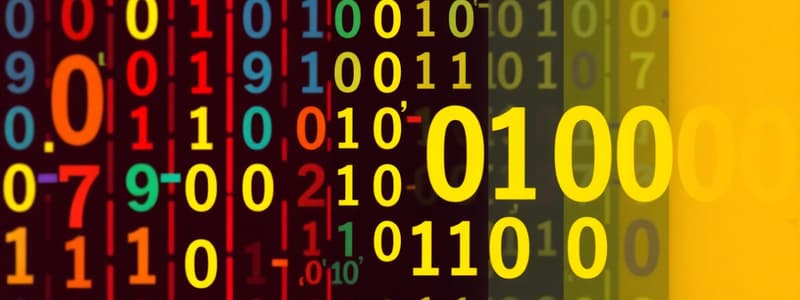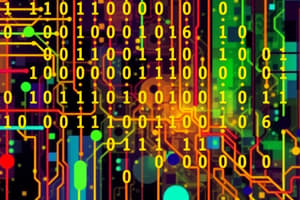Podcast
Questions and Answers
What are the two values used in binary numbers?
What are the two values used in binary numbers?
0 and 1
What is the base of decimal numbers?
What is the base of decimal numbers?
10
What are the weights used to represent the decimal number 8653?
What are the weights used to represent the decimal number 8653?
- 8 x 10^4 + 6 x 10^3 + 5 x 10^2 + 3 x 10^1
- 8 x 10^3 + 6 x 10^2 + 5 x 10^1 + 3 x 10^0 (correct)
- 8 x 10^2 + 6 x 10^1 + 5 x 10^0 + 3 x 10^-1
- 8 x 10^1 + 6 x 10^0 + 5 x 10^-1 + 3 x 10^-2
What are groups of eight bits called?
What are groups of eight bits called?
Hexadecimal numbers use digits 8 and 9?
Hexadecimal numbers use digits 8 and 9?
What is the main advantage of using binary numbers in computers?
What is the main advantage of using binary numbers in computers?
How many different values can four bits represent?
How many different values can four bits represent?
What does BCD stand for?
What does BCD stand for?
The BCD representation of 329 is the same as the binary representation of 329.
The BCD representation of 329 is the same as the binary representation of 329.
What is the term for the left-most bit in a signed binary number?
What is the term for the left-most bit in a signed binary number?
Which of the following methods are used to represent signed binary numbers?
Which of the following methods are used to represent signed binary numbers?
In 2's complement representation, the leftmost bit represents the sign, while the remaining bits represent the magnitude.
In 2's complement representation, the leftmost bit represents the sign, while the remaining bits represent the magnitude.
What is the process to obtain the 2's complement of a number?
What is the process to obtain the 2's complement of a number?
The 2's complement representation of a number is also a direct representation of its magnitude.
The 2's complement representation of a number is also a direct representation of its magnitude.
What is the key advantage of using 2's complement representation for addition and subtraction?
What is the key advantage of using 2's complement representation for addition and subtraction?
When adding two 2's complement numbers, the carry bit should be ignored.
When adding two 2's complement numbers, the carry bit should be ignored.
How is 2's complement used for subtraction?
How is 2's complement used for subtraction?
Gray code is a number system that directly represents numbers like binary or decimal.
Gray code is a number system that directly represents numbers like binary or decimal.
Gray code is not useful for reducing communication errors.
Gray code is not useful for reducing communication errors.
What is ASCII?
What is ASCII?
ASCII only maps printable characters.
ASCII only maps printable characters.
Flashcards
Binary Number System
Binary Number System
A number system that uses only two digits, 0 and 1, to represent values.
Decimal Number System
Decimal Number System
A number system that uses ten digits, 0 through 9, to represent values.
Octal Number System
Octal Number System
A number system that uses eight digits, 0 through 7, to represent values.
Hexadecimal Number System
Hexadecimal Number System
Signup and view all the flashcards
Bit
Bit
Signup and view all the flashcards
Byte
Byte
Signup and view all the flashcards
Nibble
Nibble
Signup and view all the flashcards
Base
Base
Signup and view all the flashcards
Positional Number System
Positional Number System
Signup and view all the flashcards
Conversion
Conversion
Signup and view all the flashcards
Study Notes
NET 104: Digital Logic Design - Lecture 1
- The course is about digital logic design.
- Lecture 1 is an introduction.
- Digital systems use discrete amounts of data.
- Examples include letters in the alphabet (26) and decimal digits (10).
- Larger quantities of data can be built from discrete values (e.g., words made of letters or numbers).
- Computers use binary values (0 and 1).
- Binary values are easily represented electrically using voltages and currents.
- Digital circuits are the building blocks of modern computers.
Understanding Decimal Numbers
- Decimal numbers are made of decimal digits (0-9) with a base of 10.
- Decimal numbers represent items by their positional values (e.g., 8653 = 8 x 10^3 + 6 x 10^2 + 5 x 10^1 + 3 x 10^0).
- Decimal numbers can also include fractions (e.g., 97654.35).
Understanding Binary Numbers
- Binary numbers use binary digits (bits) which are either 0 or 1.
- Binary numbers represent items by their positional values (e.g., 1011₂ = 1 x 2³ + 0 x 2² + 1 x 2¹ + 1 x 2⁰ = 11₁₀).
- Binary numbers include fractions.
- Groups of 8 bits are called a byte.
- Groups of 4 bits are called a nibble.
Understanding Octal Numbers
- Octal numbers use octal digits (0-7) with a base of 8.
- Octal numbers represent items by their positional values ((4536)₈ = 4 x 8³ + 5 x 8² + 3 x 8¹ + 6 x 8⁰ = (2398)₁₀).
- Octal numbers do not include digits 8 or 9.
Understanding Hexadecimal Numbers
- Hexadecimal numbers use hexadecimal digits (0-9, A-F) with a base of 16.
- Hexadecimal numbers represent items by their positional values.
- Hexadecimal numbers can be converted to binary easily by representing each hex digit as 4 bits (e.g., (3A9F)₁₆ = (0011101010011111)₂).
Why Use Binary Numbers?
- Binary numbers are easy to represent using electrical signals (0 or 1).
- Binary systems can tolerate noise.
- Binary data is easy to transmit.
- Binary circuits are easy to build.
Converting Between Bases
- Converting integers from decimal to another base (e.g., binary): Divide the decimal number by the target base and record the remainders.
- Converting fractions from decimal to another base: Multiply the fraction by the target base and record the integers.
Binary Coded Decimal (BCD)
- BCD encodes each decimal digit using 4 bits.
- Example: 329₁₀ = (0011 0010 1001)BCD.
- BCD is NOT the same as binary.
The Growth of Binary Numbers
- Binary numbers grow exponentially (e.g., 2⁰=1,2¹=2,2²=4...).
- Common units based on binary powers are kilo, mega, giga, and tera.
Putting it all together (Conversion examples)
- A table showing conversions between decimal, binary, octal, hexadecimal, and BCD.
Binary Addition
- Binary addition is straightforward and follows the same rules as decimal addition, but with a carry operation.
Representing Signed Numbers
- Computers represent positive and negative numbers using different methods:
- Signed magnitude
- 1's complement
- 2's complement
2's Complement Shortcuts
- Two algorithms to calculate 2's complements:
- First: Flip all bits and add 1.
- Second: Starting from the rightmost bit, copy all 0s until you encounter the first 1, then flip all the remaining bits.
2's Complement Addition and Subtraction
- Operations with 2's complement numbers use the same techniques as with unsigned numbers, with carries being ignored when appropriate.
Gray Code
- Gray code is a binary numeral system where only one bit changes between consecutive numbers.
- Gray code helps reduce errors during data transmission.
- Conversion between gray code and binary involves bit-by-bit manipulation with carries being discarded during conversion.
Studying That Suits You
Use AI to generate personalized quizzes and flashcards to suit your learning preferences.




